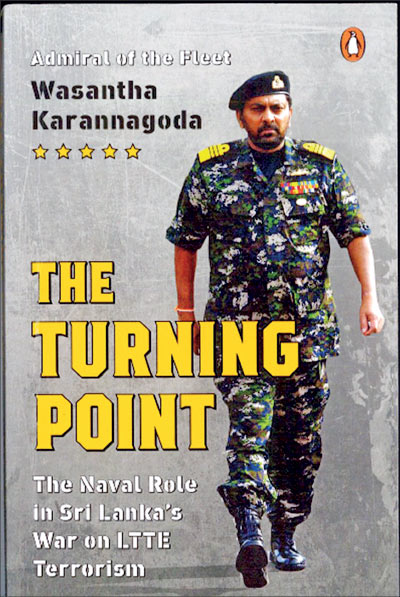Wednesday Aug 20, 2025
Wednesday Aug 20, 2025
Wednesday, 20 August 2025 12:45 - - {{hitsCtrl.values.hits}}
 The book’s emphasis on strategic and operational management makes it a valuable resource for students. Reviews suggest it is particularly suitable for management students, as it provides practical examples of decision-making under pressure, resource allocation, and innovation. For instance, Karannagoda’s decision to use a leased Indonesian passenger ship, Jetliner, to transport 3,200 security personnel, despite the risk of LTTE attacks, demonstrates bold risk management
The book’s emphasis on strategic and operational management makes it a valuable resource for students. Reviews suggest it is particularly suitable for management students, as it provides practical examples of decision-making under pressure, resource allocation, and innovation. For instance, Karannagoda’s decision to use a leased Indonesian passenger ship, Jetliner, to transport 3,200 security personnel, despite the risk of LTTE attacks, demonstrates bold risk management
 A few years ago, my son Bhanu, born in 2005, sparked a curious conversation when he asked me what I knew about “Nari.” Amused, I began explaining about foxes, only for him to interrupt, clarifying that he meant a group of people. My curiosity piqued, I listened as he described “Nari” as a defunct terrorist group. I couldn’t help but chuckle when I realised he’d mixed up “Nari” with “Koti,” the local term for LTTE cadres. When I asked where he’d heard the word, he casually mentioned a school conversation. That moment hit me hard—it was a stark reminder of how blissfully unaware his generation is of the dark chapters mine endured: the daily toll of conflict casualties, the routine checks of school bags for bombs, and newspapers perpetually filled with reports of blasts.
A few years ago, my son Bhanu, born in 2005, sparked a curious conversation when he asked me what I knew about “Nari.” Amused, I began explaining about foxes, only for him to interrupt, clarifying that he meant a group of people. My curiosity piqued, I listened as he described “Nari” as a defunct terrorist group. I couldn’t help but chuckle when I realised he’d mixed up “Nari” with “Koti,” the local term for LTTE cadres. When I asked where he’d heard the word, he casually mentioned a school conversation. That moment hit me hard—it was a stark reminder of how blissfully unaware his generation is of the dark chapters mine endured: the daily toll of conflict casualties, the routine checks of school bags for bombs, and newspapers perpetually filled with reports of blasts.
The Sri Lankan north-eastern conflict (1983–2009) was a defining chapter in the nation’s history, characterised by ethnic tensions between the majority Sinhalese and minority Tamil communities, culminating in the defeat of the Liberation Tigers of Tamil Eelam (LTTE) in 2009. For Sri Lankans born after 2000, this conflict is a distant memory, often understood through secondary sources like old newspapers or family narratives.
Admiral of the Fleet Wasantha Karannagoda’s memoir, ‘Turning Point: The Naval Role in Sri Lanka’s War on LTTE Terrorism’ (2025) by Penguin India, is released in that backdrop. It offers a firsthand perspective from a key military figure who led the Sri Lankan Navy during the war’s final phase. This article explores the potential impact of Turning Point on Sri Lankan youth born after 2000, examining how it educates them about their country’s past and the lessons it imparts for their future. By combining insights from the book’s review, historical context, and contemporary relevance, this analysis highlights the book’s role as both a historical document and an educational tool.
Turning Point of the battle with “small boats”
Turning Point chronicles Admiral Wasantha Karannagoda’s 38-year naval career, with a focus on his tenure as Commander of the Sri Lankan Navy from 2005 to 2009. The book details his strategic innovations, such as the “Small Boat Concept,” which revolutionised coastal warfare, and the interception of over 10 LTTE arms shipments in international waters, significantly weakening the LTTE’s Sea Tigers.
“After lying low for more than three months, the LTTE had decided to confront the Navy,” writes Karannagoda about the first encounter with the enemy with “small boats” aka arrow boats, “The arrow boats had completed many exercises with the Fast Attack Crafts (FACs) on attacking the Sea Tiger boats. This was the day the results of all that would be seen. Previously, the Sri Lanka Navy could put only 15-20 FACs over thirty boats of the LTTE. But this time, the Sri Lanka Navy would be deploying nearly fifty crafts against over 30 boats of the LTTE. I left my office and walked towards the operations room.”
“The battle commenced around 5 pm at a position about 4 km east of Point Pedro. The FACs destroyed two LTTE suicide boats within the first hour of the battle. Within the next thirty minutes, two more LTTE attack boats were destroyed by the arrow boats. Around 6.30 pm, the sea tigers started withdrawing towards Chalai and Mullaitivu, in the direction of the camps they came from. This battle was a huge defeat for the LTTE and a big victory for the Sri Lanka Navy.”
 Historical context of the Sri Lankan conflict
Historical context of the Sri Lankan conflict
Karannagoda’s narrative is praised for its clarity and firsthand perspective, avoiding political discourse to focus on military strategy and personal experiences. The book also recounts dramatic incidents, such as Karannagoda’s narrow escape from death in 1995 when an LTTE attack downed an aircraft he was meant to board. Described as a compelling read, Turning Point is recommended for serious readers, particularly management students, due to its insights into strategic and operational decision-making.
Karannagoda begins his narrative with the brief history of the conflict. The LTTE, formed in 1976 by Vellupillai Prabhakaran, sought an independent Tamil state in the north and east. The conflict escalated in 1983 with the LTTE’s attack on an army patrol in Jaffna, sparking widespread violence. Over the next 26 years, the war claimed 70,000–80,000 lives, with significant civilian casualties, including massacres like Anuradhapura massacre occurred in 1985 which included 146 casualties including civilian men, women and children, Aranthalawa incident that included 33 Buddhist monks, most of them young novice monks, and four civilians, the Navaly church bombing in 1995.
The LTTE’s naval wing, the Sea Tigers, was a formidable force, using suicide boats and fast attack crafts to challenge the Sri Lankan Navy. By controlling parts of the northern coastline, the LTTE relied on sea routes for arms smuggling, making naval operations critical to the war’s outcome. Under Karannagoda’s leadership, the Navy transformed from a “brown water” force, operating in coastal waters, to a “blue water” navy capable of deep-sea operations. One key strategy was intercepting LTTE “floating warehouse ships” over 3,200 km from Sri Lanka, near Indonesian and Australian waters. These efforts crippled the LTTE’s supply lines, paving the way for their defeat in 2009.
Educational value
The book’s emphasis on strategic and operational management makes it a valuable resource for students. Reviews suggest it is particularly suitable for management students, as it provides practical examples of decision-making under pressure, resource allocation, and innovation. For instance, Karannagoda’s decision to use a leased Indonesian passenger ship, Jetliner, to transport 3,200 security personnel, despite the risk of LTTE attacks, demonstrates bold risk management. These examples can inspire students in fields like business, defence studies, or public administration, encouraging them to apply creative solutions to complex problems. For young Sri Lankans, the book can instil a sense of pride in their country’s military achievements while highlighting the importance of national unity. The war’s end in 2009 marked a turning point for Sri Lanka, and understanding this history can strengthen young people’s connection to their nation’s identity.
Young Sri Lankans, often referred to as the “post-war generation,” have little direct memory of the conflict. The book imparts several lessons that resonate with them, particularly those interested in leadership, history, and national development:
How Navy saved Jetliner with Army personnel
Turning Point provides a detailed, firsthand account of the Navy’s operations, offering insights into a critical but less-discussed aspect of the war. By detailing operations like the destruction of LTTE floating warehouses, the book helps young readers understand the strategic efforts that ended the conflict. This fosters a deeper appreciation for the peace they enjoy and the sacrifices made by the armed forces. For example, the book’s account of Karannagoda’s leadership during the 2005–2009 period highlights how naval victories contributed to the broader military success, giving young readers a sense of their country’s resilience.
The reader will find it hard to put the book down because it is full of engaging narratives. Here is one such:
“On August 2, 2006, the Jetliner was returning from Kankesanturai with 1700 army personnel. It was her second voyage. As she entered the Trinco outer harbour around 2 pm, the LTTE launched an all-out multipronged attack on Jetliner with four suicide boats, eight attack boats, mortars, and artillery. The LTTE also fired artillery at the Naval Dockyard, inner harbour entrance, jetties where the FCAs were berthed, and Ashroff Jetty, where the Jetliner was berthed. The air force and army bases on the western side of the Trinco inner harbour were also attacked with artillery.”
“We were prepared for this attack and countered the LTTE’s attempt to attack the Jetliner successfully. In doing so the FACs and inshore patrol craft destroyed three suicide boats and four attack boats of the LTTE in the battle. With the destruction of their boats, the LTTE withdrew towards the Sampur area. The Jetliner entered the inner harbour without a scratch. However, some of the LTTE artillery shells that fell into the Naval Dockyard killed five trainee sailors, injured forty one sailors from the Naval and Maritime Academy. Sufficient bunkers were available at many locations in the Naval Dockyard for all personnel to take shelter. Unfortunately, the sailors got caught in the artillery fire whilst running to their designated bunkers.”
Relevance to contemporary challenges
Sri Lanka continues to face challenges like economic recovery, ethnic reconciliation, and regional security. Turning Point offers lessons in adaptability, leadership, and unity that are relevant to these issues. For example, the book’s emphasis on innovative strategies can inspire young entrepreneurs or policymakers to address economic challenges creatively. Similarly, its focus on national unity can encourage youth to advocate for inclusive policies that bridge ethnic divides.
Overall, the book is a significant contribution to Sri Lanka’s post-war literature, offering a firsthand account of the Navy’s role in defeating the LTTE. For Sri Lankan youth born after 2000, the book serves as a historical bridge, connecting them to a conflict that shaped their nation. Its educational value, lessons in leadership and strategy, and emphasis on national unity make it a powerful tool for inspiring and informing the next generation. While controversies surrounding Karannagoda may spark debate, they also encourage critical thinking, a vital skill for young people navigating Sri Lanka’s complex post-war landscape. As the country continues to address economic, social, and ethnic challenges, Turning Point provides both inspiration and cautionary lessons for building a peaceful and prosperous future.
(The writer is a policy researcher. The opinions expressed are personal. He can be reached at [email protected].)